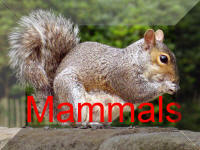Back To

Family : Mustelidae.
The European Otter is part of the same family as badgers, weasels, stoats, pine marten and mink
SizeWeight 20 -25 lbs
Habitat
The otter's main habitat the banks of rivers, lakes and streams and along the sea shore . These bank lairs or "Holts" may have an entrance chamber underwater and perhaps others from above . They are territorial and their territories cover 5 - 20 km along freshwater rivers and lakes and 1 - 3 km along the sea shore Otters live in their territories all year round and do not migrate.
Identification
Coat is mainly brown, with a lighter brown bib. They have small ears and eyes on a flattish head. otter run with a lolloping or seal like gait gait on land, and hold their long thick tapering tail off the ground.All the feet are webbed . They swim very flat on the water surface and when they dive their long tail flips over and can be seen clearly. otters have a high pitched squeak when calling to other otters and a whickering, loud angry chatter when threatening. Detected from their distinctive faeces or "Spraint"consisting mainly of fish scales and bones.or crab shell if coastal. The Otter is mainly nocturnal.
Reproduction & Developemnt
Otter first breed at 2 years of age . In the wild, an average of 1 - 2 young are born in each litter.There is no breeding 'season', although in some areas breeding has been seen to take place in spring breeding ultimately depends on the availability of food and habitat.
In the wild, an average of 1 - 2 young survive to adult hood. Males and females become independent when they reach 18 months.Diet
The main food for Otter are small fish and crabs, but like most carnivores will adapt to anything that is easy to catch or is plentiful, including birds on both the water and the shore, small mammals and larger fish.
Conservation
Otters are at the top of the food chain and have no main predator. hunting fish, small mammals and birds. The main threat to the Otter is the Man and the environmental problems he creates , Traffic, Pesticide Damage to Habitat etc. It is a Red Book species listed in the International Union for the Conservation of Natures' (IUCN) Red Book as 'vulnerable to extinction'.
